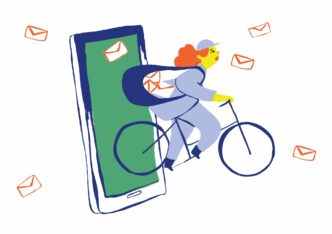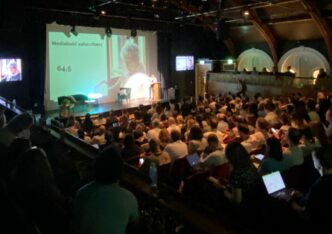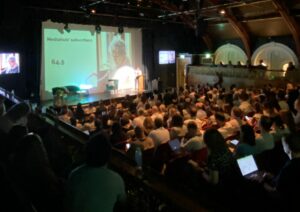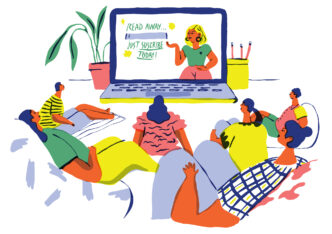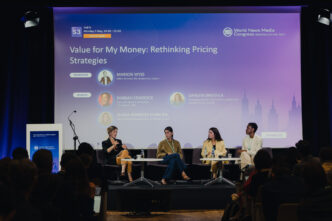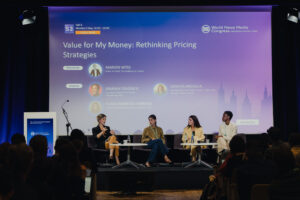

After starting her career at Molotov and Deezer, Lisa Boucher is now Head of Digital Marketing & Business Development at Lagardère News, responsible for acquiring and retaining digital subscribers for Paris Match and Journal du Dimanche. Given her experience in both the audio/video streaming industry and that of digital press, this interview focuses on the lessons that can be learnt from one to apply to the other.
Before working for online press titles, you spent a few years with Molotov (video streaming platform) and Deezer (audio streaming). What differences do you see between these worlds?

“The first, fairly obvious difference is that the media market is a little less mature than the streaming market when it comes to digital subscriptions. The fact that streaming brands are ‘pure-players’ obviously plays a key role – the user-centered, digital-first vision was adopted from the outset. On the other hand, the press is still very much infused with a print-first model and mindset making digital transformation a big challenge.
The offering is different too. In audio streaming, subscription offers are very clearly identified and there’s little difference between players – whether it’s Apple Music, Deezer, Spotify. Because of this, conversion is easier and consumers pretty much know what they’re buying into. In the press, there’s some evangelizing to be done, helping the user to see the value in the product, buy-into the brand and understand the pain-points that this particular publisher seeks to solve (compared to another publisher).
As for marketing teams within the brand, the role is a lot simpler in streaming! We operated in a logged environment where the entire user journey is tracked – we had data and knowledge for every step of the funnel. Obviously, this makes activation easier! Whilst in the press, as you’ll know, we still have a majoritively anonymous audience, which certainly complicates things.
On the other hand, everyone in the publishing industry has multiple sources of revenue. Streaming may have advertising to some extent, but subscription is the predominant model and all strategies tend to be focused on developing the subscriber base.”
In your experience, does it make sense to divide business into subscriber acquisition and retention?
“Not at all!
When I joined Deezer in 2017, I was placed in a new position, in charge of engagement and retention, the latter of which was always considered as a secondary subject, even though we know that retention costs less! I worked in tandem with someone in charge of acquisition and then the two of us worked hand-in-hand with product and content teams.
At Molotov, my role was to grow the subscriber portfolio. We didn’t have a team dedicated to user acquisition for B2C (the acquisition strategy was based more on developing distribution partnerships) – the focus was more on retention, how to convert people who are already there.
Finally, at my current job at Lagardère, my job is attached to the Digital Department for press and radio. When I arrived, the marketing team was focused on analytics, engagement and traffic acquisition as well as having someone in charge of our CRM actions (push and email). We’ve now expanded the team to include an SEO manager, someone in charge of paid subscriber acquisition (paid campaigns), and a cross-functional person working on subscriptions, who also works with the print teams. We also have a Product Officer dedicated to digital subscriptions.
Our whole team is needed to successfully develop our subscriber portfolio.
We have small teams, but even with an unlimited budget I’m not sure I’d want to split roles up. It’s important to remain consistent and collaborative, bringing editorial, product, etc together to guarantee that we see the user as a whole, that we’re not siloed.”
What retention KPIs are you tracking at Lagardère News?
“At Lagardère, we monitor changes in the subscriber portfolio, conversion and churn, in that order.
On the acquisition side, we break down the tunnel with Poool’s framework: premium visibility rate, paywall visibility rate, paywall click rate, final conversion rate.
On the retention side, we’re currently working on LTV (life-time value) with the goal of monitoring it more closely and ensuring that we have optimal acquisition costs. We measure 12-month LTV to have a view of the whole year – i.e. how much revenue a subscriber brought in over 12 months. We’re not yet at the point of monitoring this on an ongoing basis, but we do keep an eye on performance to put our acquisition campaigns into perspective, ensuring that we’re profitable.
What I can already say is that, compared with streaming platforms, it’s harder to convert users into subscribers in the press industry, but they’re more loyal after converting!”
Are performance indicators the same for streaming platforms?
“Not quite, because streaming is a 100% logged environment. When I worked for Molotov and Deezer, we monitored 2 KPIs:
- Conversion at day 0: people who converted on the same day as their registration
- Conversion at day 30: people who convert within 30 days of creating an account
This is cohort reasoning. The starting point of our relationship with a user is when they create an account.”
And how is ARPU (average revenue per user) monitored?
“At Deezer and Molotov, we were of course tracking ARPU, which is derived from LTV. At Lagardère, we’re just getting started. It’s less manageable for print, but we’re turning the corner for digital.
Our challenge today is whether we include advertising revenues in the mix. Today we don’t, but we’d like to in the future.
Specifically, we’d like to know exactly how much a single user brings to our business, all sources of revenue combined.”
Let’s talk about the impact of price on retention. Does offering highly discounted subscriptions in the first few months have an impact on subscriber loyalty?
“At JDD, we have a special offer of €1 for the first month. This used to be free, but we wanted to avoid users having a lower perceived value of our product as well as limit churn associated with payment problems.
This move didn’t have any significant impact on performance – we did have a few fewer conversions, but that was more than offset by retention. Specifically, with the free trial, we had more cancellations when the subscriber reached the end of the month, so we were forced to put in place a stronger promotional offer.
And the issue of promotions and their damage to retention isn’t just in the short-term. You need to consider 3 metrics:
- Conversion on the promotional offer
- Switch rate to full price
- Retention on the full price offer
At Deezer, for example, we only had two promotional offer periods – winter and summer, with a 3-month discount. Then there was our flagship offer of “First month free”. Spotify had the same.
During these offer periods we knew that we were better at recruiting new subscribers, but we saw a big deterioration in retention rates over the medium term. With this strategy, the question is simple: does the uplift in conversion rates compensate for the fall in retention?
We were still generating growth, but it was less so over time… the market got bored.
And I get the impression that it’s the same in the press… maybe too much promotion damages brand perception?
Especially as, in the digital press, there’s a lot of free information on offer and considerable competition to acquire subscribers, with plenty of attractive promotional offers amongst players. Put this together and it likely doesn’t help to improve the perceived value of a publisher’s content.”
Is onboarding new subscribers important when working on subscriber retention?
“Onboarding is essential – it’s the 1st step in retention!
Just because a reader has given us their card details doesn’t mean they’ve been acquired, far from it! As a publisher, we have to continuously remind new customers why they signed up in the first place.
Whether a user understands the environment or not (which is the difference between streaming and media), the rule is always that you should show new subscribers around and lead them through some onboarding steps.
At Deezer, most of the onboarding was done as soon as a user downloaded the app to ensure they created an account. This onboarding started with a personalization step, asking users to choose artists they liked from a given genre, with sub-genres, etc. The app would then recommend relevant playlists & artists with the goal of developing usage from the outset.
The second onboarding goal is to make users stay. At the JDD we do this with a series of emails, welcoming them and promoting features that increase engagement, such as the app. Results are looking good so far – click-through and open rates are high, and emails are perceived as a service to our subscribers. We’re not working on rolling this strategy out on Paris Match.
We’ve also done a lot of work on our app onboarding. Several screens explain how the app works and encourage readers to create an account.”

What onboarding measures can be put in place for websites?
“The first challenge is to log users to then expose them to on-site campaigns. Without a user ID, we can’t do anything!“
… and then segment to work on retention group by group?
“Yes, of course. When it comes to retention, we need to identify highly engaged users and those at risk of churning.
At Molotov, we set up an RFV segmentation (Recency, Frequency & Volume).
For free users we needed to identify those with a high propensity to subscribe, but this implied knowing the user and having their data…
As for paying subscribers, we tracked the RFV metrics to be able to react if engagement dropped. If this was the case, a user would be presented with CRM actions, such as pushes or emails with the goal of lifting these metrics back up. For instance, we might push more enticing content in the app.
The signals that were most suggestive of imminent churn were:
- Any change in frequency of use patterns (be careful, we’re looking to see if there’s a change in the pattern, not the frequency in absolute terms, which may simply be a weak consumption habit)
- Recency – date of last use of the product
But of course, to score users within given segments, you need data. That’s why, at Lagardère News, we’re in the process of equipping ourselves with a data lake.”
Let’s talk about subscribers who have left… What win-back strategies work?
“When it comes to win backs, mega promotions don’t necessarily work. In fact, it only works if the user leaves because of the price.
Instead, you have to remind the user of all the content and functionalities they’ll lose out on by canceling – in short, we play on FOMO (fear of missing out)!
At Le JDD and Paris Match, we’ve set up a dedicated paywall for former subscribers.

They don’t get much exposure, but they work very well.
We also run email campaigns with discretionary offers for this audience segment.
But the real winner amongst all win-back campaigns is to anticipate users at risk, and that requires a detailed understanding of the customer and how they distance themselves from the product.”
Are you worried about the effects of the new legislation requiring 3-click cancellations?
“It’s a big risk for us… it’s obviously going to affect retention, and that applies to the whole sector. Although, it may lead to better conversion figures because users will value the no-commitment aspect of subscribing and the ease of leaving.”
Last question: at Lagardère, are you considering the possibilities offered by different kinds of AI to help you acquire or retain subscribers?
“For the moment our challenge is to have exhaustive and reliable data. First of all, we want to improve our data/marketing stack, to be 100% clean in terms of our user knowledge. And then, in 2024, we’ll be looking at how we can intelligently activate this data.”
The Audiencers’ newsletter: from professionals to professionals
Sign up to our newsletter – real-life examples, expert points of view and inspirations from publishers around the world to help you do your job better. Sent every two weeks.

